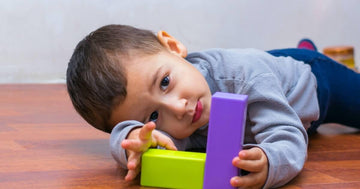So, you did the research and read the reviews and you bought the toy that is meant to be perfect for your child. But you find them not interested in it at all. Has this ever happened to you? Wondering where you went wrong?

Dr. Maria Montessori said that the adult is bridge between the child and the environment. And that no matter how perfectly and beautifully you prepare the environment for the child, they may not use it the way it is meant to unless you act as the link. So what does this mean for you, your child and the toy that you bought for them?
Here are some thoughts to ponder about.
- The toy that you bought must meet your child’s interest. You will know this when you observe your child, for example, if your child has shown interest in climbing then the Pikler Triangle is a great aid for them or if they have shown interest in putting things into other boxes or taking things out of boxes then they may be ready for the object permanence box.
- Observation will also help you understand your child’s abilities. The toy must also meet your child’s skill level – sometimes even though children show interest in a particular activity, their fine and motor skills may not be at the level to be able to use that yet. For example, you bought your child the teether, but they may not yet be able to hold it and mouth it (although they really want to). The best thing to do in this case is give your child to figure it out and not interfere. With an activity like the first puzzle – you can present the activity to your child.
- Presenting an activity is a Montessori term which simply means to show your child how to use the materials or toy. Presentations are demonstrations that have certain parts.
- An invitation – you can say, “Come, let me show you how to use this/work with this/play with this.” Or “Look, what has come in the mail, let me show you how to play with this”. If your child refuses at this point itself, please don’t push or force them to see the presentation. Try again another time or day.
- The set- up – taking the toy or activity from the shelf to the mat or table where it is meant to be used. At this point, you can also show your child how to carry the material, walk with it and where to put it down.
- The presentation - this is the part where your show your child how to work with or play with the toy – this needs to be done slowly and deliberately. Don’t talk when you show, and don’t show when you talk. Make sure your child can see all your movements clearly.
- The handover – keep your presentation short and to the point. Avoid using this as a conversation started or to give your child information. Toddlers don’t have a very long attention span and it is very easy to lose their interest. As soon as your present, give your child a turn to work with is if they show interest. Delaying the handover may cause your child to lose interest in the activity.
- The winding up – let your child work with or play with the toy if they please. Once they are done, show them where the toy goes after play – you can do this in collaboration with your child – you take this, I’ll take this.
Always remember to set up activities in an inviting manner on a shelf or workspace. Don’t set up too many activities at the same time as this may overwhelm the child. Remember that only if the space looks inviting to us will the child show interest in it as well. All activities and toys are always an offering and an invitation to the child – they have the option and right to say no – don’t take it personally. And above all, don’t stress about it too much – have faith and trust that the child will approach the activity according to their inner timetable which may not always sync with what we think.







